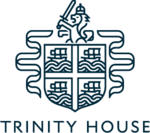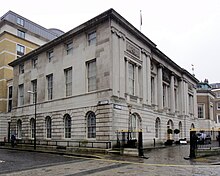The Corporation of Trinity House of Deptford Strond | |
 | |
 The headquarters at Trinity House in Tower Hill, London, built in 1796. | |
| Formation | 20 May 1514 |
|---|---|
| Founded at | Deptford, London, England |
| Legal status | Royal Charter corporation and registered charity |
| Purpose | Maintenance of lighthouses, buoys and beacons |
| Headquarters | Trinity House, Tower Hill, London, England |
Region | |
Membership |
|
Master | The Princess Royal |
Deputy Master | Rear Admiral Iain Lower[1] |
Revenue | £37,907,000 (2022)[2] |
| Expenses | £44,208,000 (2022)[2] |
| Staff | 283 (2022)[2] |
| Website | trinityhouse.co.uk |


The Corporation of Trinity House of Deptford Strond,[3] also known as Trinity House (and formally as The Master, Wardens and Assistants of the Guild Fraternity or Brotherhood of the most glorious and undivided Trinity and of St Clement in the Parish of Deptford Strond in the County of Kent), is the official authority for lighthouses in England, Wales, the Channel Islands and Gibraltar. Trinity House is also responsible for the provision and maintenance of other navigational aids, such as lightvessels, buoys, and maritime radio/satellite communication systems. It is also an official deep sea pilotage authority, providing expert navigators for ships trading in Northern European waters.
Trinity House is also a maritime charity, disbursing funds for the welfare of retired seamen, the training of young cadets and the promotion of safety at sea. For the financial year ending in March 2013, it spent approximately £6.5 million in furtherance of its charitable objectives.[4]
Funding for the work of the lighthouse service comes from "light dues" levied on commercial vessels calling at ports in the British Isles, based on the net registered tonnage of the vessel. The rate is set by the Department for Transport, and annually reviewed.[5] Funding for the maritime charity is generated separately.
The corporation was founded in 1514. Its first master was Thomas Spert (later Sir), sailing master of Henry VIII's flagship Mary Rose and of Henry Grace à Dieu.
- ^ "Rear Admiral Iain Lower becomes Deputy Master and Chief Executive of Trinity House". Trinity House. 13 February 2024. Retrieved 27 February 2024.
- ^ a b c "Trinity House Report and Accounts 2021-22". Trinity House. 2022. Retrieved 3 July 2023.
- ^ "Legal Notices". Trinity House. Archived from the original on 16 December 2009. Retrieved 28 April 2015.
- ^ "Charities we Support". Trinity House. Retrieved 28 April 2015.
- ^ "Funding". Retrieved 28 April 2015.